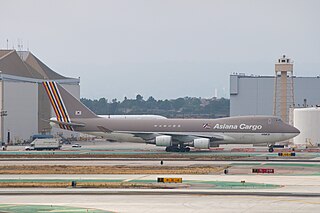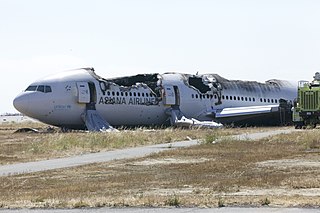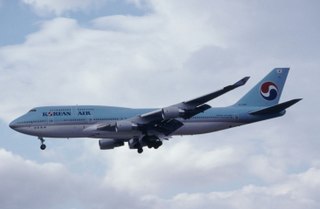Transportation in South Korea is provided by extensive networks of railways, highways, bus routes, ferry services and air routes that traverse the country. South Korea is the third country in the world to operate a maglev train, which is an automatically run people mover at Incheon International Airport.

Incheon International Airport is the largest airport in South Korea. It is the primary airport serving the Seoul Capital Area and one of the largest and busiest airports in the world. Since 2005, it has been rated the best airport worldwide by Airports Council International every year. It is also rated as the world's cleanest airport and the world's best international transit airport by Skytrax.
Korean Air Co., Ltd., operating as Korean Air, is the largest airline and flag carrier of South Korea based on fleet size, international destinations and international flights. The airline's global headquarters is located in Seoul, South Korea. The present-day Korean Air was established on March 1, 1969, after the Hanjin Group acquired government-owned Korean Air Lines, which had operated since June 1962. Even though Korean Air is owned by Hanjin Group, KAL is controlled by majority of Hanjin KAL Corporation. The owner family of Hanjin Group is still the airline's largest and controlling, shareholder; Cho Won-tae, its current chairman and CEO, is the third generation of the family to lead the airline. As of 5 June 2020, Hanjin KAL holds 29.27% of Korean Air shares. Korean Air is a founding member of the airline alliance SkyTeam and SkyTeam Cargo.
Asiana Airlines Inc. is a South Korean airline headquartered in Seoul. In 2019, it accounted for 25% of South Korea's international aviation market and 20% of its domestic market. It maintains its international hub at Seoul's Incheon International Airport and its domestic hubs at Gimpo International Airport, also in Seoul, and Gimhae International Airport in Busan.

Hiroshima Airport is an airport in the city of Mihara, Hiroshima Prefecture, Japan. Located 50 km (31 mi) east of Hiroshima, it is the largest airport in the Chūgoku region.

Port Harcourt International Airport is an international airport located in Omagwa, a suburb of Port Harcourt, the capital city of the Rivers State in Nigeria. The airport has two terminals for both international and domestic flights. The new International terminal which was commissioned by the executive president of the Federal Republic of Nigeria President Muhammadu Buhari on October 25, 2018. In 2009, the airport served 1,081,587 passengers, making it the third-busiest airport in Nigeria.

Jeju International Airport is the second largest airport in South Korea, just behind Incheon Airport in Incheon. It is located in the city of Jeju. The airport opened in 1968.
Jeju Air Co., Ltd., is the first and largest South Korean low-cost airline. It offers scheduled domestic services, as well as international destinations including China, Japan, Russia, the Mariana Islands, and various Southeast Asian countries. It is also a founding member of the Value Alliance. Jeju Air is named after the Jeju Island. The airline, a member of AK group, has opened a Seoul head office tower hotel at Hongik station of the Seoul Metro, to diversify income.

El Nouzha Airport or Alexandria International Airport was an international airport serving Alexandria, Egypt, 7 km (4.3 mi) southeast of the city center. In 2009, the airport served 1,142,412 passengers. The airport has been shut down for major renovations in 2011 while all traffic was transferred to Borg El Arab Airport. However, it has been announced that the airport will no longer reopen.
The article describes accidents and incidents on Korean Air and its predecessor companies Korean National Airlines and KAL. Korean Air had many fatal accidents between 1970 and 1999, during which time it wrote off 16 aircraft in serious incidents and accidents with the loss of 700 lives. The last fatal accident, Korean Air Cargo Flight 8509 in December 1999 led to a review of how Korean cultural attitudes had contributed to its poor crash history. Since then safety has improved.

Asiana Airlines Flight 733 was a domestic Asiana Airlines passenger flight from Seoul-Gimpo International Airport to Mokpo Airport (MPK), South Korea. The Boeing 737 crashed on July 26, 1993, in the Hwawon area of Haenam County, South Jeolla Province. The cause of the accident was determined to be pilot error leading to controlled flight into terrain. 68 of the 116 passengers and crew on board were killed.

Gunsan Airport is an airport serving Gunsan, a city in the North Jeolla Province in South Korea. In 2019, 306,518 passengers used the airport. It shares its runway with Kunsan Air Base, which uses the same IATA and ICAO codes.

Eastar Jet (ESR) is a South Korean low-cost airline with its headquarters in Banghwa-dong, Gangseo-gu, Seoul. On January 7, 2009, Eastar Jet made its maiden flight from Gimpo International Airport to Jeju International Airport. Now, the airline operates a scheduled passenger network to 14 destinations in eight countries. Its main base is Gimpo International Airport, with a hub at Jeju International Airport.
Air Busan Co., Ltd., operating as Air Busan is a low-cost airline based in Busanjin-gu, Busan, South Korea. It is a subsidiary of Asiana Airlines. The airline began its operation in 2007 as Busan International Airlines Company ; it launched service in October 2008.

On 22 December 2009, an American Airlines Boeing 737-800, operating American Airlines Flight 331 and carrying 148 passengers and six crew, overran runway 12 on landing at Kingston in poor weather. The plane continued on the ground outside the airport perimeter and broke apart on the beach, causing injuries.

On 28 July 2011, Asiana Airlines Flight 991, a Boeing 747-400F cargo aircraft on a flight from Seoul, South Korea, to Shanghai, China, crashed into the sea off Jeju Island after suffering a main deck fire. Both pilots, the only two people on board, were killed.

Asiana Airlines Flight 214 was a scheduled transpacific passenger flight originating from Incheon International Airport near Seoul, South Korea. On the morning of July 6, 2013, the Boeing 777-200ER crashed on final approach into San Francisco International Airport in the United States. Of the 307 people on board, 3 died; another 187 were injured, 49 of them seriously. Among the seriously injured were four flight attendants who were thrown onto the runway while still strapped in their seats when the tail section broke off after striking the seawall short of the runway. It was the first fatal crash of a Boeing 777 since the aircraft type entered service in 1995.
Korean airline crash may refer to crashes involving various Korean-based airlines, including:

Korean Air Flight 8702, operated by a Boeing 747-400, departed Tokyo, Narita International Airport on 5 August 1998 at 16:50 for a flight to Seoul, scheduled to arrive there at 19:20. Bad weather, including heavy rainfall, at Seoul forced the flight crew to divert to Jeju. The aircraft took off from Jeju at 21:07 for Seoul. The flight was cleared to land on runway 14R with a crosswind component as the wind was from 220 degrees at 22 knots. Upon touchdown, the aircraft rolled off the runway. The aircraft slid into a ditch. The undercarriage was destroyed by the impact and the fuselage split. After the crash, the inside of the aircraft caught fire, but all the occupants were able to evacuate the aircraft.

Asiana Airlines Flight 162 was a regular short-haul international passenger flight from Incheon International Airport near Seoul, South Korea, to Hiroshima Airport in Hiroshima, Japan. On 14 April 2015, the Airbus A320-232 aircraft touched down short of the runway, struck the localizer array, skidded onto the runway on its tail, and spun 120 degrees before finally coming to a rest on the grass, opposite the terminal building. The aircraft suffered substantial damage to the left wing and engine. Of the 82 people aboard, 27 were injured, one seriously.













